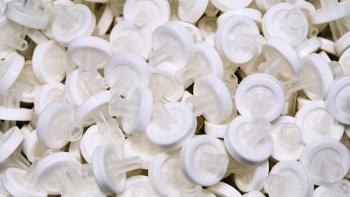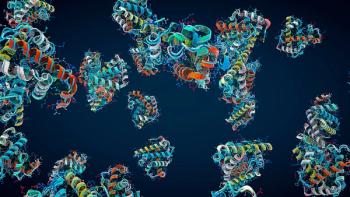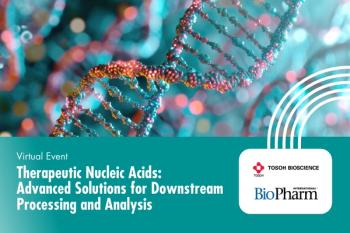
- BioPharm International-06-02-2009
- Volume 2009 Supplement
- Issue 4
The Impact of Cell Culture Medium on Cell Line and Process Development Timelines and Strategies
ACF medium sped up cell-line development.
ABSTRACT
Cell culture medium plays a significant role in determining the cell density, viability, and productivity of a robust manufacturing process. Current regulatory requirements prefer bioprocesses that do not use any animal-derived components throughout cell line and cell culture development. However, using media containing serum for early stages of cell line development is still a common practice for deriving stable production cell lines for manufacturing. The ideal medium should be able to support all activities in the cell line and process development stages for maintaining consistent cell populations and product quality. Here, we describe such performance by an in-house-developed, universal animal component free (ACF) medium that can support transfection, amplification, subcloning, banking, and production of the different Chinese hamster ovary (CHO) cell lines generally used for recombinant protein production. By using this ACF medium, designated as MTCM, there was an overall reduction in cell line development time for two distinct expression systems by eliminating the adaptation period between serum-containing medium to ACF medium. Furthermore, by using the same basal medium throughout cell line and process development, transitional changes in growth characteristics, productivity, and heterogeneity in the cell populations were simultaneously kept to a minimum. Finally, a robust and high yielding upstream production platform technology for human monoclonal antibodies (HuMAbs) was developed by using MTCM both as basal and feed media in fed batch cultures. This accelerated CHO cell culture optimization that led to 6 g/L HuMAb production and facilitated an efficient process integration of upstream and downstream.
Productivity enhancement by CHO cell culture to several grams/L has been revolutionizing the biomanufacture of recombinant therapeutic antibodies.1 The development of antibodies and their derivatives with close to 200 clinical trials largely depends on the knowledge gathered about CHO expression systems, which has enabled the biotech industry to accelerate the development of its pipeline candidates. It is also forecasted that CHO production systems will play a crucial role in future biomanufacturing processes because of their capability to produce high expression titers,1–3 in some cases equivalent to those of transgenic animals (approximately 10 g/L), along with desirable post-translational modifications.
Tim Diehl
The development of cell culture medium has been one of the major efforts contributing to the significant improvements in product titer in the past by supporting high cell densities and extending culture longevity in fed-batch mode. Often, production medium for high titer processes is different from that used during the earlier stages of cell line development, including transfection and subcloning, where single-cell derived colonies need to grow. Medium with serum is often used at these early cell line development stages for both adherent as well as suspension cell cultures. These recombinant cell lines are then slowly adapted to ACF media or chemically defined (CD) media during the later stages of development, for inoculum expansion and recombinant protein production. These transitional phases can take a considerable amount of time for cell lines to adapt to such medium shifts and for process development scientists to select stable, high producers from a diversified population. Here, we describe upstream process development using a proprietary medium throughout the cell line and process development phases.
Materials and Methods
Transfection and Cell Line Development
Transfections of different CHO host cell lines were carried out using a single expression plasmid containing the heavy and light chain genes of a human antibody. A BioRad Gene pulser was used to electroporate the DNA into either a dhfr-deficient (dhfr–, Expression System I) or dhfr-containing (dhfr +, Expression System II) CHO cell line. Transfected cells were plated in 96-well plates and antibody levels in media with selection pressure were measured using a human IgG kappa/gamma sandwich ELISA. The highest producing cell lines were expanded and single-cell cloned by limiting dilution.
Subcloning and Cell Bank Preparation
An aliquot of actively growing cells was diluted in complete growth media to yield 0.25, 0.5, or 1.0 cell/well, and 10–20 x 96-well flat-bottom tissue culture plates were plated. Distinct clones that were confirmed to have originated from single cell/well were evaluated to identify the highest IgG expressing clones. A clone possessing the highest productivity was expanded to prepare a research cell bank. Master cell banks and manufacturer's working cell banks were further established from research cell banks.
Cell Culture Process and Analysis
Recombinant CHO cells were grown in shake flasks or 5- to 85-L scale stirred tank bioreactors (from Applikon, Bellco, or Bioengineering) in batch and fed-batch modes. The temperature and CO2 level were controlled for cell culture incubators. The pH, dissolved oxygen (DO), agitation, and gas flows were also controlled if cells were cultured in bioreactors. In fed-batch mode, feed media were added according to the feeding schedules that were tailored to the specific recombinant cell line. Cell density and cell viability were measured using Cedex (Innovatis), Vicell (Beckman Coulter) cell counters or by a manual hand count using the Trypan blue exclusion method. Antibody concentrations were determined by Protein A HPLC (Waters).
Medarex proprietary media for research, development, and large-scale manufacturing were formulated in both powder and liquid forms from a media vendor.
Copy number analysis
Genomic DNA was purified from transfected and untransfected CHO cell lines. Gene-specific primers and a fluorescent probe for a TAQman method were developed by Applied Biosystems using the following two assays. A murine dhfr assay was used to determine the number of dhfr copies of the expression plasmid integrated into the CHO genome. A rodent gapdh assay was used to determine the number of genomes present in the same sample tested for dhfr for normalization. The reactions were thermal cycled and data was collected using the ABI Prism 7300 Sequence Detection System (Applied Biosystems).
Results and Discussion
A universal medium that can support transfection, selection, and amplification, along with cell culture optimization for high productivity, has time and cost advantages. Such a medium not only reduces overall timelines for cell culture development but also provides a uniform process development platform by minimizing the changes caused by intermittent adaptation processes. A concerted effort to develop a Medarex proprietary medium, MTCM A, as part of an integrated cell line and cell culture process development, was carried out for a HuMAb CHO production platform. This medium was further optimized by adjusting the levels of nutrient requirements for our cell lines, and an improved second-generation medium, MTCM B, was derived. These two versions of MTCM media, with minor changes in composition, can support transfection, amplification, subcloning, and production, and were successfully used for the development of different but related CHO cell lines for HuMAb production. The genealogy of the CHO host cell lines that are generally used for recombinant expression is depicted in Figure 1.
Figure 1. Genealogy of commonly used CHO host cell lines
Reduction in Cell Line Development Timelines
Expression System I with CHO dhfr– host cell lines. Standard transfection and amplification of a CHO dhfr– cell line are performed by plating cells in serum containing commercially available media after electroporation and subsequently increasing the methotrexate (MTX) concentration to 500 nM in the same 96-well plates. These cell lines may be further amplified to 2 μM MTX in batch cultures. The process has included two rounds of subcloning, occurring before and after adaptation to the serum-free commercially available medium, followed by adaptation to MTCM medium. This entire process takes approximately 12 months (Figure 2A).
Figure 2. Effect of using a single medium throughout cell line development for Expression Systems I and II
Conditions were then developed to accelerate the process in the commercial medium without serum right from the initiation of cell line development, a process that included optimizing transfection efficiency. This shortened the cell line development timeline by up to four months and eliminated the need for a lengthy serum-weaning process and one round of subcloning (Figure 2A). However, using only MTCM media during the entire process of cell line development would eliminate media transitions and potentially reduce the timeline to seven months for a 2 μM MTX amplified cell line (Figure 2A).
Expression System II with CHO dhfr+ host cell lines. A similar process could be carried out with Expression System II, which does not require amplification. Initial protocols used serum in a commercially available medium at the transfection stage, which was then removed during adaptation. In a manner similar to Expression System I above, the conditions were optimized using the same commercially available medium without serum throughout transfection and subcloning. As Figure 2B indicates, by using only MTCM media, we could accelerate the cell line development timeline to five months. In addition, further reduction in the timeline by another month could be achieved using bulk transfection and selection methods.
In both cases, pre-adapted host cell banks in MTCM media were generated in a serum-free freezing mixture. Transfection with these well-characterized host cell banks eliminated media transitions and reduced the timelines for cell line development, as illustrated in Figure 2.
Amplification Using MTCM Media
In a controlled experiment for Expression System I (Figure 3), CHO colonies in 96-well plates were gradually amplified to 1 μM MTX in a commercial medium (parental 1 μM) and subcloned (clone 1 μM). The parental line was heterogeneous, as indicated by the increase in gene copy number from 18 to 40 upon subcloning. On the other hand, the efficiency of MTCM media for amplification was monitored by amplifying up to 500 nm MTX and subcloned (Figure 3). This process yielded a cell line (clone 0.5 μM) with 23 gene copies and better volumetric productivity compared to the parental cell line (parental 0.5 μM). Several MTCM-derived clones were pooled and amplified to 2 μM MTX. The pooled culture was increased from an average of 29 gene copies per cell at 500 nm MTX (pool 0.5 μM) to 34 copies at 2 μM MTX (pool 2 μM). Subcloning of the bulk amplified pool resulted in cell lines (clone 2 μM) producing over 500 mg/L in batch culture with 47 and 54 gene copies per cell. Copy number analysis clearly demonstrated the increase in gene copies and productivities in correlation with increasing resistance to higher MTX concentration in MTCM medium. In addition, bulk amplification was also successful with MTCM media, as monitored by qPCR copy number analysis.
Figure 3. Productivity and gene copy number analysis during amplification and subcloning for a HuMAb cell line derived from Expression System I
Subcloning Efficiency Using MTCM Media
CHO-derived HuMAb cell lines were plated at 0.25, 0.5, and 1.0 cell/well and were used to measure the subcloning efficiency of MTCM first- and second-generation media. Even when plated at 0.25 cell/well, recombinant cell lines generated from both expression systems were able to grow to 10 to 90% cloning efficiency (Table 1). High-titer cell culture processes can be successfully developed further from these subclones after appropriate upstream process development. In a case of Expression System I using MTCM A medium, MTCM medium outperformed two commercially available ACF media when the same parental cell line was subcloned by limiting dilution. Approximately 227 colonies were obtained from MTCM medium by plating at 1.0 cell/well in 20 x 96 well plates (Table 1), whereas no colonies appeared in the other two commercial ACF media (not shown). As shown in Table 1, these two versions of MTCM media supported high efficiency cloning for CHO recombinant cell lines derived from both expression systems.
Table 1. Cloning efficiency of MTCM on recombinant cell lines derived from Expression Systems I and II
Preparation of Cell Banks with MTCM Media
Cryopreservation of cells for manufacturing was performed with the two versions of MTCM media for different recombinant cell lines. These banks were periodically monitored to check recovery of the cells for further subculturing and the inoculum expansion process for upstream manufacturing. Freezing the cells at varying densities, from 1 to 3 x 107 cells/mL, was successful in a freezing mixture containing either MTCM A or MTCM B and dimethyl sulfoxide. These cells were thawed with >85% viability for all CHO cell lines tested (Table 2). One of the cell banks was evaluated for recovery and propagation after five years and was found to have the same performance as at the time of banking. To date, more than 20 recombinant CHO cell banks have been made in MTCM media and used in different manufacturing processes. Inoculum expansion processes for manufacturing are consistent and robust with the banks prepared and stored in these ACF basal media. Using ACF media from early stages of cell line development also reduces safety concerns from exogenous contaminants.
Table 2. Use of MTCM for cell bank preparation of different CHO recombinant cell lines from Expression Systems I and II
HuMAb Production with MTCM Media
HuMAb batch processes with MTCM A and B were developed that can yield up to 1 g/L without feed addition. In general, MTCM B supports better cell growth and longevity of the culture, and as a result, leads to better productivity in batch and fed-batch processes. For example, Figure 4 shows that, cell culture processes in MTCM B not only reached higher peak cell density, but also expressed higher antibody levels for both batch and fed-batch compared to those in MTCM A.
Figure 4. Comparison of first and second generation MTCM basal media for a HuMAb production using Expression System I
Feed formulations and feed strategies have been developed by tailoring them to one or two basic generic processes with MTCM A or B basal media to reach high expression levels. In most cases, when high productivity is demanded in short timelines, these processes only need minimal optimization time. These fed-batch processes range from 2 to 6 g/L HuMAb production with MTCM basal and feed media combinations for cell lines derived from these two expression systems, which can increase productivity up to 11 fold compared to batch cultures (Figures 5 and 6).
Figure 5. Fed-batch processes in bioreactors using Expression System II for two different HuMabs. A) MTCM B used as basal medium, combined with MTCM feeds for cell line 1 from Expression System II, with an 11-fold increase in productivity from batch to fed-batch. B) MTCM B used as basal medium, combined with MTCM feed for cell line 2 from Expression System II, with a 10-fold increase in productivity from batch to fed-batch.
High yield processes also can be developed using commercially available chemically defined basal media along with MTCM feed media (Figure 7). Up to a 13-fold increase in productivity was observed when using commercial basal medium with MTCM feed and feed strategies from our generic processes. However, it is reported that there are usually only 2–5 fold productivity gains from media and process optimization efforts.10
Figure 6. Fed-batch processes in bioreactors for Expression System I for two different HuMAbs. MTCM B used as basal medium, combined with MTCM feeds for two cell lines from Expression System I, with a 7-fold increase in viable cell density from batch to fed-batch.
Using MTCM as a feed medium in combination with commercial basal media from different vendors or using MTCM as a basal medium with different commercial feed media demonstrated the broad applicability of MTCM compositions for high yield upstream processes.
Figure 7. Combination of commercial chemically defined basal media with MTCM feed media for two different HuMAbs. A) Chemically defined CHO basal medium combined with MTCM feed for a cell line from Expression System I with 2,000 nm methotrexate (MTX), showing a 10-fold increase in productivity from batch to fed-batch. B) Chemically defined CHO basal medium combined with commercial feed, compared to MTCM feed for a cell line derived from Expression System II, showing a 3-fold and 13-fold increase, respectively, in productivity from batch to fed-batch.
Process Development Strategies and Advantages
The biotechnology industry depends on robust manufacturing cell lines to produce biologics. The timelines for deriving a stable manufacturing cell line suitable for consistent process scale-up requires thorough screening and subcloning of the initial transfectant population. In the case of suspension dhfr– CHO cell cultures, amplification procedures using MTX prolongs this process. However, the recombinant cell lines derived from Expression System II have a more straightforward development time, which can take approximately seven months to adapt from serum-containing transfection to serum removal and subcloning. Through careful development of MTCM medium that can support different activities, we were able to significantly reduce the timeline from transfection to cell line selection for both expression systems (Figure 2). Recombinant cell lines derived from both expression systems can use the same medium without serum right from the transfection stage. Using one medium throughout all upstream process development phases also helps retain the higher productivity carried from early clones by eliminating media shifts.
A robust CHO-based high yielding platform technology was established for HuMAb manufacturing. With this strategy, media inventory became much more streamlined for different process development stages as well as for manufacturing. Basal medium compositions can be manufactured in both liquid and powder formulations that support growth and production equally well. The powder form of both basal and feed media has been successfully manufactured up to the 450-kg scale and shown to be stable for more than two to three years, which has facilitated convenient inventory maintenance for multiple processes of different HuMAb molecules. Powder formulations provide a convenient means of transport and storage of large batches for commercial-scale manufacturing and also decrease the costs associated with testing and releasing multiple media lots. Overall, manufacturing efficiency and timelines are favorably influenced for a wide variety of antibody candidates and also resulted in more operation-friendly processes by using common media requirements for different CHO cell lines. In addition, knowledge of medium formulations provides better insights during upstream process optimization. Furthermore, using in-house media can significantly reduce the manufacturing cost of goods, and medium cost can be lowered as much as 60% compared to commercially available media (Table 3).
Table 3. Comparison of MTCM media costs to commercially available media for different manufacturing scales
Conclusion
Overall, we significantly reduced resource requirements and substantially shortened cell line development timelines by optimizing a proprietary cell culture medium, MTCM, for all upstream process phases including transfection, amplification, subcloning, banking, and production. Medium changes are some of the most influential factors affecting the heterogeneity of cell populations with respect to post-translational or secondary modifications. Integrating medium screening into the process as early as the clone selection step focuses process development efforts, not only on deriving high productivity clones, but also on maintaining comparable biochemical profiles of the molecule for desired therapeutic potency.11
Using a single cell culture medium from early-stage cell line development all the way through high-titer production significantly affected the process development strategies to obtain stable, robust production cell lines and high yielding cell culture processes. It allows for more predictable feed streams for downstream processes and enables an efficient integration of process technologies.12 It also leads to effective regulatory strategies by supporting economical processes starting at early clinical phase production.
ALAHARI ARUNAKUMARI, PhD, is the senior director of process development and the corresponding author, XIAO-PING DAI, PhD, is the assistant director of bioprocess development, JOEL GOLDSTEIN, PhD, is the associate director of transfectoma development, CLAUDIA KLOTH, PhD, is the senior manager of upstream process validation, bioprocess development, HAILE GHEBREMARIAM is the assistant director, cell line development, GLENN MACISAAC is a scientist II, cell line development, and MELISSA WAGNER is a scientist I, cell line development, all at Medarex Inc., Bloomsbury, NJ,
References
1. Hacker DL, Nallet S, Wurm FM. Recombinant protein production yields from mammalian cells: past, present, and future. BioPharm Int. Guide to Protein Production. 2008 June supplement: 6–15.
2. Adamson SR. A new era in biotechnology. BioProcess Int. Conference & Exhibition. 2006 Nov 7–9; San Francisco, CA.
3. Coco-Martin JM, Harmsen MM. A review of therapeutic protein expression by mammalian cells. BioProcess Int. 2008 June supplement: 28–33.
4. Puck TT, Ciecuira SJ, Robinson A. Genetics of somatic mammalian cells. III. Long-term cultivation of euploid cells from human and animal subjects. J Exp Med. 1958;108(6):945–956.
5. Urlaub G, Chasin LA. Isolation of Chinese hamster cell mutants lacking dihydrofolate reductase activity. Proc Nat Acad Sci. 1978;77:4216–20.
6. Graf LH, Chasin LA. Gamma rays induce gross alterations in the DNA sequence of the dihydrofolate reductase gene. Molec Cell Biol. 1982;2:93–6.
7. Urlaub G, Kas E, Carothers AM, Chasin LA. Deletion of the diploid dihydrofolate locus from cultured mammalian cells. Cell. 1983;33:405–12.
8. Urlaub G, Mitchell E, Kas E, Chasin LA, Funanange VL, Myoda TT, Hamlin JL. The effect of gamma rays at the dihydrofolate reductase locus: deletions and inversions. Somatic Cell Molec Genet. 1986;12:555–66.
9. Yamane-Ohnuki N, Kinoshita S, Inoue-Urakubo M, Kusunoki M, Iida S, Nakano R, Wakitani M, et al. Establishment of FUT8 knockout Chinese hamster ovary cells: an ideal host cell line for producing completely defucosylated antibodies with enhanced antibody-dependent cellular cytotoxicity. Biotechnol Bioeng. 2004;87(5):614–22.
10. DePalma A. Changing needs drive the media market customized cell culture media predicted to increase productivity while decreasing costs. Gen Eng Biotech News. 2008;28(2).
11. Gerber MA, Arunakumari A, Huang D, Goldstein J, McNorton S, Drew B, et al. Integrated strategies for clone and media formulation selection. BioProcess Int. 2008;6(1):58–63.
12. Arunakumari A. Integrating high titer cell culture processes with highly efficient purification processes for the manufacturing of human monoclonal antibodies. BioProcess Int Conference & Exhibition. 2006 Nov 7–9; San Francisco, CA.
Articles in this issue
over 16 years ago
Production Strategies for Antibody Fragment TherapeuticsNewsletter
Stay at the forefront of biopharmaceutical innovation—subscribe to BioPharm International for expert insights on drug development, manufacturing, compliance, and more.




